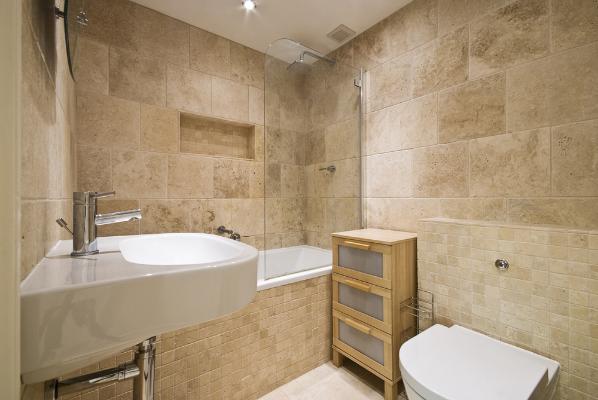Mold in showers is a common occurrence in most houses. Mold can grow in a variety of settings, but among the most common are naturally occurring stone surfaces like tile and grout. Because natural stone surfaces are permeable, if routine care is neglected, mold may develop on them.
Mold can grow on stone surfaces as well, such as natural stone shower stalls. You must eliminate mold from your natural stone shower stall as soon as you discover it growing in order to stop it from spreading and becoming harder to get rid of.
Natural stone adds a touch of richness and refinement to a bathroom’s design. It’s important to know how to maintain natural stone tiles because it’s usual to use natural stone to build a fashionable and functional shower.
Maintaining a natural stone shower may seem daunting, but all it needs is a little cleaning once a week.
Kind Of Molds:

There are several ways that mold can develop on natural stone shower surfaces. The most common type of mold is called black mold, which is the most prevalent type of mold that may be identified by its black or greenish-black color. Other types of mold include white, pink, and blue mold. Each type of mold has different characteristics and requires a different cleaning strategy. For example, pink and blue mold require hydrogen peroxide or vinegar solutions to be removed, whereas black mold should be treated with a bleach solution.
Natural Solutions For Eliminating Mold:

Use A Solution Of Bleach And Water.
A bleach and water solution can be made by mixing one cup of bleach with one gallon of water. Fill a spray bottle to the brim with a large amount of the mixture, then lightly sprinkle the moldy areas. Allow it to sit for around thirty minutes and then give it a brush scrub. After giving the area a thorough rinse with clean water, let it air dry.
Apply The Vinegar Solution.
Vinegar, a mild acid, is a safe treatment for natural stones. To clean the moldy areas in your shower, use one part vinegar with three parts water. Apply the solution on a sponge or towel, then use a gentle scraping motion to remove the mold. Next, give the area a good rinse with fresh water.
Use A Water Solution With Baking Soda Or Powder.
Baking soda or powder can be used to remove mold from natural stone showers. Put a paste, including soda or baking powder, and water on the areas where mold is growing. Give it a thorough brush after allowing it to sit for thirty minutes. After giving the area a water wash, pat it dry. If the stains are still stubborn, try hydrogen peroxide, which is one part hydrogen peroxide to two parts water. Apply a generous amount to the injured area. Use a sponge or cloth to clean it after allowing it to sit for ten to fifteen minutes. Repeat as necessary, then give it a thorough rinse and let it air dry.
As the primary cause of mildew is an abundance of moisture in the air, make sure your shower is well ventilated by using exhaust fans and running hot showers for a minimum of five minutes before entering.
Hire A Professional Cleaner.
If your shower includes natural stone, it is imperative that you keep it mold-free and spotless. Using a professional-made cleaning solution designed specifically for natural stone is the most efficient way to accomplish this. The MB-9 Mold and Mildew Eliminator is a highly recommended option. Simply mist it on, let it sit for a few minutes, and then wipe it off with a cloth. You will be shocked at how successful it ends up being.
Natural Stone Shower Cleaner: To avoid stains, mishaps, and stone damage, it’s essential to clean your natural stone bathroom using the right solution. Sadly, acidic cleansers will dissolve the sealer that is protecting your stone, so sealing dense stone is advised to keep it from collecting moisture and growing mildew or stains. For this reason, you should avoid using any harsh chemical cleanser, such as distilled white vinegar, that contains ammonia, vinegar, or bleach.
To maintain natural stone tiles, use a pH-neutral (pH level 7 is neutral) natural, non-acidic cleaning.
Cleaning Advice For Natural Stone Shower:
- Scrub every surface with the mixture using a brush or sponge. Another tool you could use to scrub harder, less clean areas is steel wool.
- Rinse the surface with water after thoroughly cleaning it to remove any dirt and debris.
- Allow the shower to air dry completely after cleaning it, as the combination may cause the stone to become slick.
- Apply stone cleanser to the shower on a regular basis once it has fully dried. The mold stains will be removed by the cleanser’s acid.
- After letting the cleanser stay on the stone for a few minutes, scrape it off using a brush or sponge. If necessary, steel wool is an additional option; however, excessive use of it may damage the stone’s surface.
- Rinse away all of the cleaner and dirt after scrubbing, then let the shower air dry once more before reapplying a stone sealant layer.
- Use a stone sealant to prevent future mold growth on or around your natural stone showers after the shower has completely dried.
FAQs:
Is It Possible To Bleach Natural Stones Using Bleach?

Bleach can damage natural stone if it is not used properly. To avoid damaging your stone, follow these recommendations:
- Always test a small portion of a stone to make sure it’s safe.
- Only use dry surfaces for bleaching.
- Wear safety goggles and gloves when working with bleach.
- Allow the stone to completely dry before using water or any other cleaner.
Can Natural Stone Be Safely Treated With Hydrogen Peroxide?
Hydrogen peroxide is safe to use on natural stone, provided it is diluted properly. To avoid discoloration or harm to your stone, dilute hydrogen peroxide with water before applying it.
Does White Vinegar Cause Damage To Stones?
This will depend on the type of stone being used and how often it is cleaned. Conversely, white vinegar is an excellent cleaning solution for stones, effectively dissolving any accumulated dirt, dust, or debris.
Conclusion:
Mold removal in natural stone showers can be difficult due to their porous nature. Your patience and detail-orientedness will be essential to removing this problem from your surface. You should also use an antimicrobial cleaner, which can remove germs, fungi, viruses, and other microorganisms on contact. This way, you’ll steer clear of any enduring problems later on.
If you’re looking for advice on how to care for and maintain your natural stone shower, we hope that our blog post on how to remove mold from a natural stone shower has been helpful. The easiest way to decide which cleaning products will work best on it is to ascertain what kind of material it is made of. Mold can usually be removed off any surface by diluting vinegar with water, as long as there isn’t an overwhelming quantity of debris or dirt caked onto the surface beforehand.

